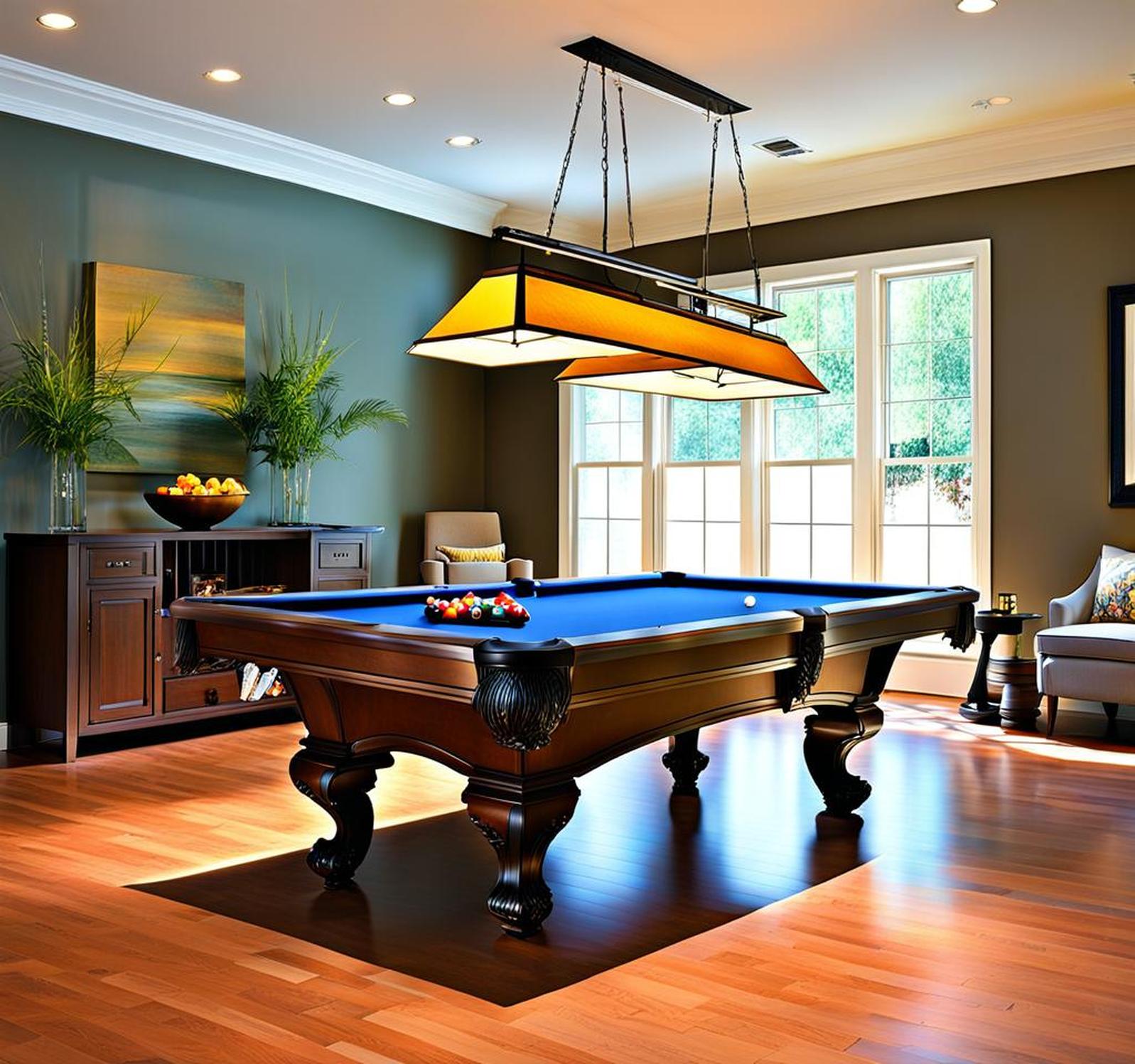Do you love playing pool but struggle with a table crammed into a tiny room? It’s frustrating when tight quarters lead to bumped elbows, tricky shots, and constant do-overs. But don’t stash your cue in the closet just yet! Understanding optimal pool table room sizes can transform even the pokiest space into a stellar pool hall.
You’ll learn clearances for smooth shooting, walkways, seating, lighting, and more spatial considerations. We also share creative small room hacks so you can enjoy your beloved game to the max. Let’s rack ’em up!
Pool Table Dimensions To Know
Before measuring your space, it’s essential to know key pool table dimensions. Let’s review standard sizing for the most common recreational pool tables.

Standard Pool Table Sizes
There are three regulation sizes for rectangular pool tables designed for homes and casual play:
- 7-foot: measures 84 by 42 inches (playing surface area). This is best for tighter spaces.
- 8-foot: measures 92 by 46 inches. The most popular residential size.
- 9-foot: measures 100 by 50 inches. Allows more challenging shots.
You may also see specialty custom shapes and sizes like 6-foot bars boxes or massive 10-foot behemoths for professional matches.
Other Key Table Measurements
In addition to the playing surface dimensions above, consider these specs:
- Rails around the rim are typically 4 inches high on all table types.
- Weight can range from 650-1000 lbs. Ensure your floor can handle it.
Appropriate Cue Stick Lengths
Your pool cue dimensions also impact how much swing room your pool table setup requires. Let’s review regulation stick lengths and flexibility.
Regulation Pool Cue Dimensions
Standard pool cues for casual home games measure:
- Length: 57 to 58 inches
- Tip size: typically 12 to 13 millimeters
- Weight and flexibility: 18-21 ounces with varying bend for stroke control
Cue Considerations for Room Size
When looking at pool table room dimensions, factor in full cue lengths when estimating clearance:
- Allow enough space for backswings, follow-through, and full strokes around the table’s perimeter.
- In very cramped rooms, bridge sticks help reach shots without a full backswing.
Measuring Your Room Size
Now let’s get into the nitty gritty formulas to find ideal room dimensions for various pool table setups.
Length & Width Needed
Here are the minimum room sizes needed for tight corner placements of common table sizes:
- 7-foot table: 13 x 16 feet
- 8-foot table: 13.5 x 17 feet
- 9-foot table: 14 x 18 feet
See the overhead views below showing tight spacings for reference:
| 7-foot Table | 8-foot Table | 9-foot Table |
|---|---|---|
| Diagram | Diagram | Diagram |
Other Spatial Considerations
Don’t forget to measure:
- Ceiling height : Minimum 8 feet. Up to 9 feet for larger rooms.
- Light fixtures : Avoid placement directly above the table surface to prevent shadows.
- Columns/obstacles : Consider protruding architectural elements that can limit playable space or obstruct shots.
Recommended Clearance Around Table
While the room sizes above provide a tight baseline, best practice is to allow substantial clearance around the table for game play.
Leave Space to Move Around
Be sure to leave open floor for:
- Walking area behind the table: 3 foot width minimum
- Seating/accessories: 2 feet behind head string and side rails
Comfortable Shooting Clearance
Additionally, leave margins from playing surface to walls for cue strokes:
- Sides/end rails: 2-3+ feet gap
- Cue tip to rails: 4-5 feet (less advanced players can get by with 2-3 feet)
Creative Solutions for Tight Spaces
Limited on basement or apartment room dimensions? Try these clever tricks to maximize playability:
Make the Most of What You Have
- Use rail bridges for cramped corner shots
- Opt for shortie cues under 52 inches
- Wall mount racks, chalk, etc. to save floor space
When All Else Fails
- Knock down a wall if constructing a room addition is within budget
- Size down to a 7-foot table or specialty shape like a 6-foot bar box
We hope this guide brought clarity to the pressing question of exactly how much space you need for a pool table setup. Remember, bigger tables need more room dimensions, but you can make most any space work with clever shuffles and downsizes.
For quick reference, check our printable pool table room size cheat sheet. And when ready to shop for your perfect fit, try our custom pool table calculator to input your room specs and game needs.
Now grab a cue and leave those tight shots behind! With your new room ratios, enjoy endless games with flow and focus. Break time!
